What Is Dragon Fruit and Does It Have Health Benefits?
Dragon fruit isn’t just pretty to look at with its bright pink skin and speckled flesh – it’s actually a super refreshing fruit that’s good for you too. It’s low in calories, packed with fiber, and loaded with antioxidants. Flavor-wise, think somewhere between a pear and a kiwi, with just the right amount of sweetness.
The cool thing about dragon fruit is how versatile it is. You can slice it up and eat it straight with a spoon, toss it into yogurt for breakfast, or blend it into a smoothie for a colorful boost. Some people even throw it into salads to add a fun tropical twist.
And here’s the bonus – beyond the taste and Instagram-worthy vibes, research suggests dragon fruit might also support digestion, boost your immune system, and help keep your skin glowing. So yeah, it’s not just a trendy fruit, it’s one worth keeping around in your kitchen.
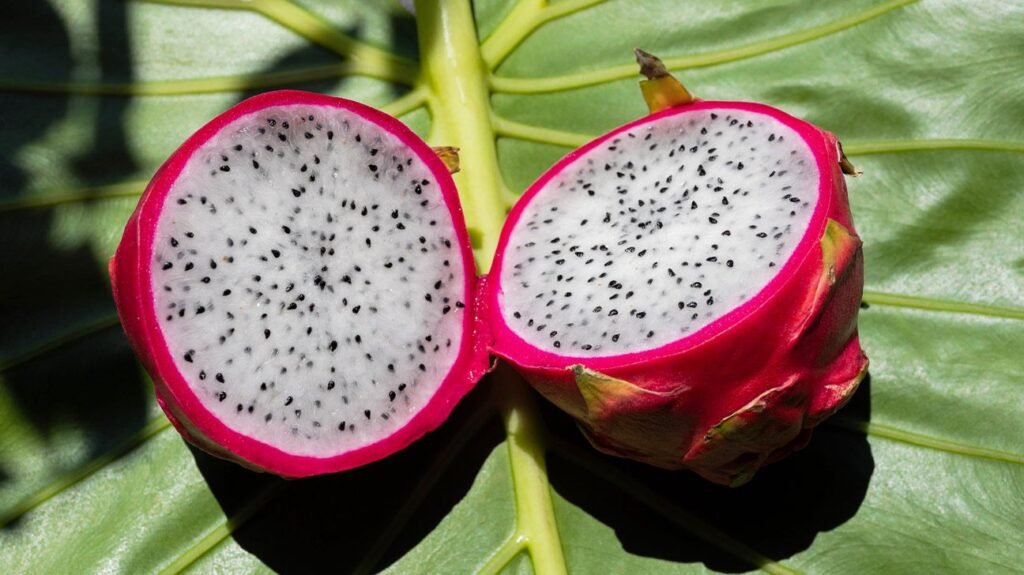
What is dragon fruit?
Dragon fruit actually grows on a cactus called Hylocereus, also nicknamed the Honolulu queen. Fun fact: its huge, fragrant flowers only bloom at night. Originally, the plant comes from southern Mexico and Central America, but these days it’s grown all around the world.
You might hear it called by a few different names – pitaya, pitahaya, or even strawberry pear. The most common types have that bold red skin with green “dragon-like” scales, which is how it got its name. Inside, most varieties have white flesh with tiny black seeds, but there’s also a red-fleshed version that’s a little harder to find. And if you ever spot a yellow dragon fruit with white pulp, that’s another variety worth trying.
Despite looking like something from a fantasy novel, the flavor is actually familiar. Most people describe it as mildly sweet, kind of like if a kiwi and a pear had a tropical baby.
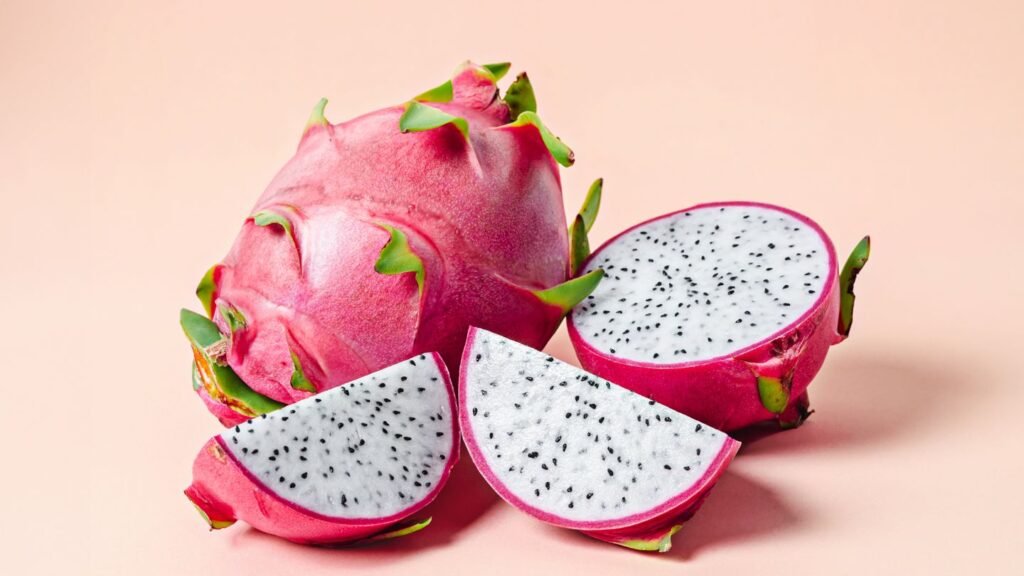
Nutrition facts
Dragon fruit may look like a treat for the eyes, but it’s pretty kind to your body too. It’s low in calories and gives you a mix of vitamins, minerals, and fiber without weighing you down. A 100-gram serving (about 3.5 ounces) looks something like this:
- Calories: 57
- Protein: 0.4 g
- Fat: 0.1 g
- Carbs: 15 g
- Fiber: 3 g
- Vitamin C: 5% of your daily value
- Iron: 1% of your daily value
- Magnesium: 2% of your daily value
So while it’s not a heavy hitter in protein or fat, dragon fruit makes up for it with fiber, a little vitamin C for immunity, and minerals like iron and magnesium that help keep your energy and muscles in check.
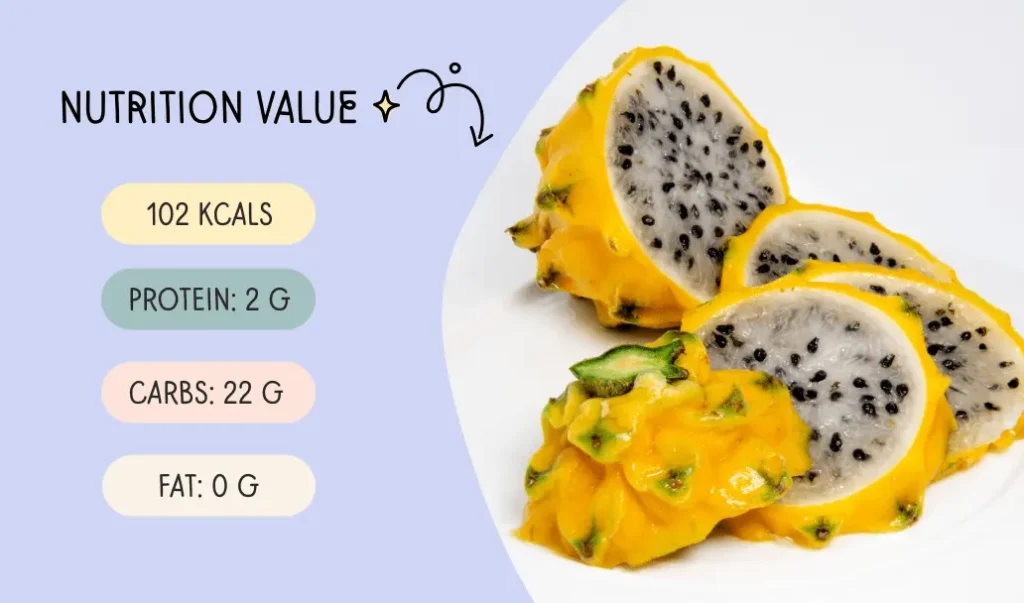
Provides several antioxidants
Dragon fruit isn’t just about fiber and vitamins – it’s also loaded with antioxidants. These are the compounds that help protect your cells from damage caused by free radicals (the unstable molecules linked to aging and chronic disease). In simple terms: antioxidants act like a shield for your body.
Here are a few of the standout ones in dragon fruit pulp:
- Betalains – These give red dragon fruit its deep color. Research shows they may help lower cholesterol and reduce markers tied to heart disease risk.
- Hydroxycinnamates – A fancy name for a group of compounds that, in lab studies, have shown anticancer potential.
- Flavonoids – A big family of antioxidants connected to brain health and a lower risk of heart disease.
Interestingly, when scientists compared the antioxidant power of 17 tropical fruits and berries, dragon fruit didn’t top the charts overall. But it did stand out in one area – it was especially good at protecting certain fatty acids in the body from free radical damage.
Potential health benefits
A lot of what we know about dragon fruit’s health benefits actually comes from animal studies. While that means we can’t take the results as 100% proof for humans, the findings are still pretty interesting. Most of the benefits seem to come from the fruit’s fiber and antioxidant content.
For example, both red and white dragon fruit varieties have been shown to reduce insulin resistance and fatty liver in obese mice. In one study, mice on a high-fat diet that received dragon fruit extract gained less weight, had less liver fat, and showed reduced inflammation. Researchers think this might be linked to positive changes in gut bacteria – thanks to the fruit’s prebiotic fiber.
That same prebiotic fiber feeds the “good” bacteria in your gut, which could play a role in better metabolic health overall. But it’s not all clear-cut. In a 2014 study, mice given dragon fruit juice had better blood sugar control and lower levels of certain liver enzymes, while another liver enzyme actually went up. So, mixed results.
Older studies also hint at benefits. Diabetic rats treated with dragon fruit extract saw a 35% drop in malondialdehyde (a marker of free-radical damage) and had less stiffness in their arteries compared to untreated rats.
As for people? The evidence is still pretty limited and a bit inconsistent. Some small studies suggest dragon fruit could help with type 2 diabetes, but researchers agree more solid human trials are needed before drawing big conclusions.
Adverse effects
For most people, dragon fruit is completely safe to eat. But like with almost any food, there’s a small chance of an allergic reaction. It’s rare, but it has happened.
In fact, there are two documented cases where women with no history of food allergies developed serious reactions (anaphylaxis) after eating a fruit mix that included dragon fruit. Follow-up testing showed their immune systems had developed antibodies against it.
Those are the only two reported cases so far, but it does mean there’s a possibility others could be allergic without realizing it. So if you’re trying dragon fruit for the first time, it’s worth keeping that in mind.
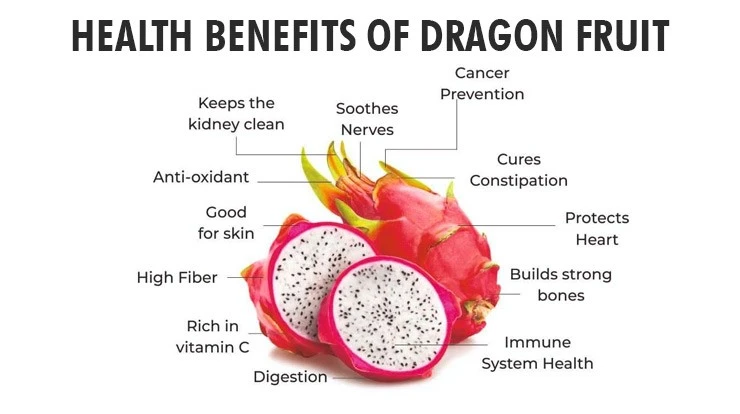
How to eat it Dragon Fruit
Even though dragon fruit looks a little intimidating at first glance, it’s actually super easy to prepare.
Here’s a simple way to eat it:
- Pick one that’s ripe — the skin should be bright, evenly colored, and give just a little when you press it (kind of like an avocado).
- Slice it in half with a sharp knife.
- From there, you can scoop the flesh out with a spoon or peel off the skin and cut the fruit into chunks.
Tasty ways to enjoy it:
- Eat it plain and chilled — simple and refreshing.
- Dice it up and toss it over Greek yogurt with a handful of nuts.
- Add it to a fruit salad for a tropical twist.
Some people even blend it into smoothies or use it as a colorful topping for smoothie bowls. However you serve it, dragon fruit adds a fun pop of color and a mild, refreshing sweetness.
The bottom line
Dragon fruit is light, low in calories, and has less sugar and fewer carbs compared to a lot of other tropical fruits. Early research and animal studies suggest it may have some real health perks, but we’ll need more human studies to know for sure.
At the end of the day, it’s not just about the nutrition — dragon fruit is also fun to eat, surprisingly versatile, and adds a splash of color to your plate. If you’re looking to mix things up with your fruit choices, this one’s definitely worth a spot in your diet.
Health Benefits and Nutrition Facts About Dragon Fruit
Dragon fruit, sometimes called pitahaya or strawberry pear, is a tropical fruit that looks almost too pretty to eat. With its bright pink skin and speckled, kiwi-like pulp, it’s become a favorite not just for its Instagram-worthy appearance but also for its nutrition.
It’s naturally low in calories, yet it delivers fiber, antioxidants, and prebiotics — all things your body actually appreciates. Add in the hype around its “superfood” status, and you can see why health-conscious folks have jumped on board.
The best part? You don’t need to live somewhere tropical to try it. Fresh and frozen dragon fruit is now stocked in supermarkets all over the world, so it’s easy to add to your routine.
Here are 7 science-backed health benefits of dragon fruit that make it more than just a pretty face.
1. High in nutrients
Dragon fruit doesn’t just look good — it’s surprisingly nutritious too. It’s low in calories but still manages to pack in vitamins, minerals, and a solid dose of fiber.
Here’s what you’ll get in about one cup (180 grams) of dragon fruit:
- Calories: 103
- Protein: 0.6 g
- Fat: 0.2 g
- Carbohydrates: 27.4 g
- Fiber: 5.6 g
- Iron: 0.3 mg
- Magnesium: 12.6 mg
- Vitamin C: 7.7 mg
- Vitamin E: 0.2 mg
So while it’s not exactly a protein powerhouse, dragon fruit makes up for it with fiber, vitamin C for immune support, magnesium for muscle and nerve health, and small amounts of other key nutrients. Basically, it’s a sweet way to sneak in some extra goodness without overloading on calories.
Dietary Guidelines for Americans (USDA)
- The exact amount of nutrients you need each day depends on your age and sex — that’s why organizations like the Dietary Guidelines for Americans set recommended values as a benchmark. Dragon fruit won’t cover all your daily needs on its own, but it definitely contributes in a healthy way.
- And it’s not just about vitamins and minerals. Dragon fruit also brings in plant-based compounds like polyphenols, carotenoids, and betacyanins. These act as antioxidants, helping to protect your cells and support overall health.
2. May help fight chronic disease
Free radicals are unstable molecules that can damage your cells and drive inflammation — over time, that’s linked to health problems like heart disease, diabetes, cancer, and even arthritis. One of the best ways to fight back is through your diet, especially with foods rich in antioxidants.
Dragon fruit happens to be one of them. It contains several powerful antioxidants, including vitamin C and carotenoids, which help neutralize free radicals and keep them from causing too much trouble in your body.
It’s worth noting that antioxidants are most effective when they come from whole foods like dragon fruit. Supplements, on the other hand, don’t offer the same benefits and can even be harmful if taken without medical guidance. So, in this case, food really is the best medicine.
3. Loaded with fiber
Fiber is one of those underrated nutrients that does a lot more than just keep your digestion running smoothly. Research suggests a high-fiber diet may also help lower the risk of heart disease, type 2 diabetes, and even support a healthy body weight. Some studies even hint that fiber could play a role in reducing the risk of colon cancer, though more research is needed.
Dragon fruit isn’t a magic bullet for these conditions, but it does give you a good boost of fiber to help you reach your daily needs. One thing to keep in mind: if you’re not used to eating much fiber, jumping straight into a high-fiber diet can cause stomach issues like bloating. The trick is to increase it gradually and drink plenty of water so your body adjusts.
4. Promotes a healthy gut
Your gut is home to a massive community of microbes — we’re talking around 100 trillion of them. And researchers believe the balance of these microorganisms plays a big role in overall health. When things get out of balance, it’s been linked to issues ranging from digestive troubles to heart disease.
That’s where dragon fruit might help. It contains prebiotics, a special kind of fiber that feeds the “good” bacteria in your gut. Unlike regular nutrients your body absorbs, prebiotics pass through your digestive system and serve as food for beneficial bacteria, helping them grow and thrive. In return, those bacteria support digestion, immunity, and more.
Regularly eating prebiotic-rich foods like dragon fruit may help reduce the risk of gut infections and even diarrhea, since the healthy bacteria can outcompete the harmful ones. That said, most of the research looks at prebiotics in general — not dragon fruit specifically — so more studies are needed to confirm its unique impact.
5. Strengthens your immune system
A strong immune system depends on many things, and what you eat is definitely part of the equation. Dragon fruit gives you a little boost here thanks to its vitamin C and carotenoids, both of which act as antioxidants.
Your white blood cells are basically your body’s defense squad, hunting down harmful substances that can make you sick. The problem is, they’re pretty vulnerable to damage from free radicals. That’s where antioxidants come in — they help neutralize those free radicals, keeping your immune cells protected so they can do their job.
Adding fruits like dragon fruit to your diet won’t magically make you invincible, but it can help support your body’s natural defenses over time.
6. May boost low iron levels
Dragon fruit is actually one of the few fresh fruits that provides iron — and that makes it pretty special. Iron is essential for moving oxygen through your body and converting the food you eat into energy. Without enough of it, you’re likely to feel tired and run down.
The tricky part? Iron deficiency is really common. In fact, it’s estimated that about 17% of the world’s population doesn’t get enough. While meat, fish, legumes, nuts, and fortified cereals are usually the go-to sources, dragon fruit can be a nice addition to help boost your intake.
Pairing iron-rich foods like dragon fruit with a source of vitamin C (which dragon fruit also happens to have) can help your body absorb it more effectively.
7. Good source of magnesium
Dragon fruit also stands out for its magnesium content, offering more than most fruits. Your body only carries around 25 grams of magnesium in total — roughly an ounce — but don’t let that small number fool you. This mineral is a quiet workhorse, playing a role in more than 300 different enzyme systems.
Magnesium is involved in all kinds of essential processes: making proteins, keeping your muscles and nerves working properly, regulating blood sugar and blood pressure, building strong bones, even helping create DNA. It also supports the conversion of food into energy, so your body can actually use what you eat.
Some research suggests that getting more magnesium may help lower the risk of conditions like heart disease, diabetes, and stroke, though more studies are needed to confirm those links. Still, adding fruits like dragon fruit to your diet is a simple way to boost your intake
How to cut dragon fruit
Despite its intimidating appearance, dragon fruit is surprisingly easy to cut and enjoy—especially when it’s ripe.”
Step 1: Slice in half
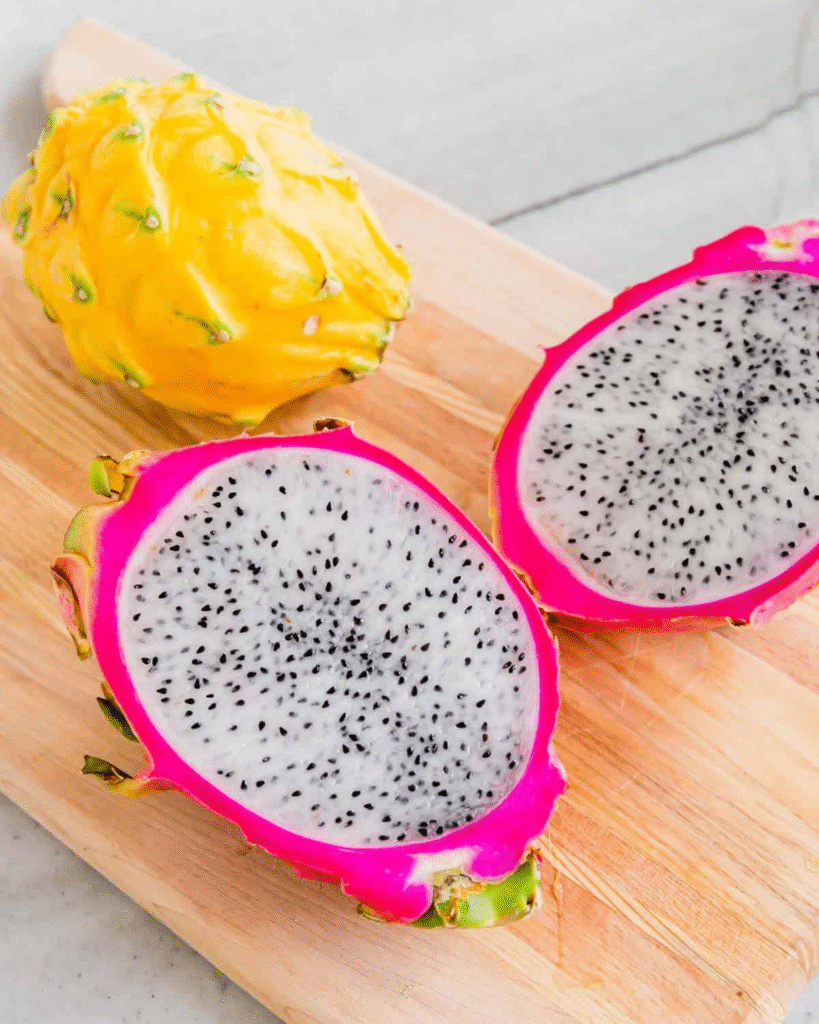
No matter if you plan to slice, cube, or scoop spheres, the first step in cutting dragon fruit is to slice it in half lengthwise. The skin might look tough, but it’s actually quite easy to cut through with a sharp knife. I usually start at the end without the thick stem and work on a flat surface like a cutting board. Once opened, the vibrant flesh is revealed—ready for you to prepare however you like
Step 2: Remove from the peel
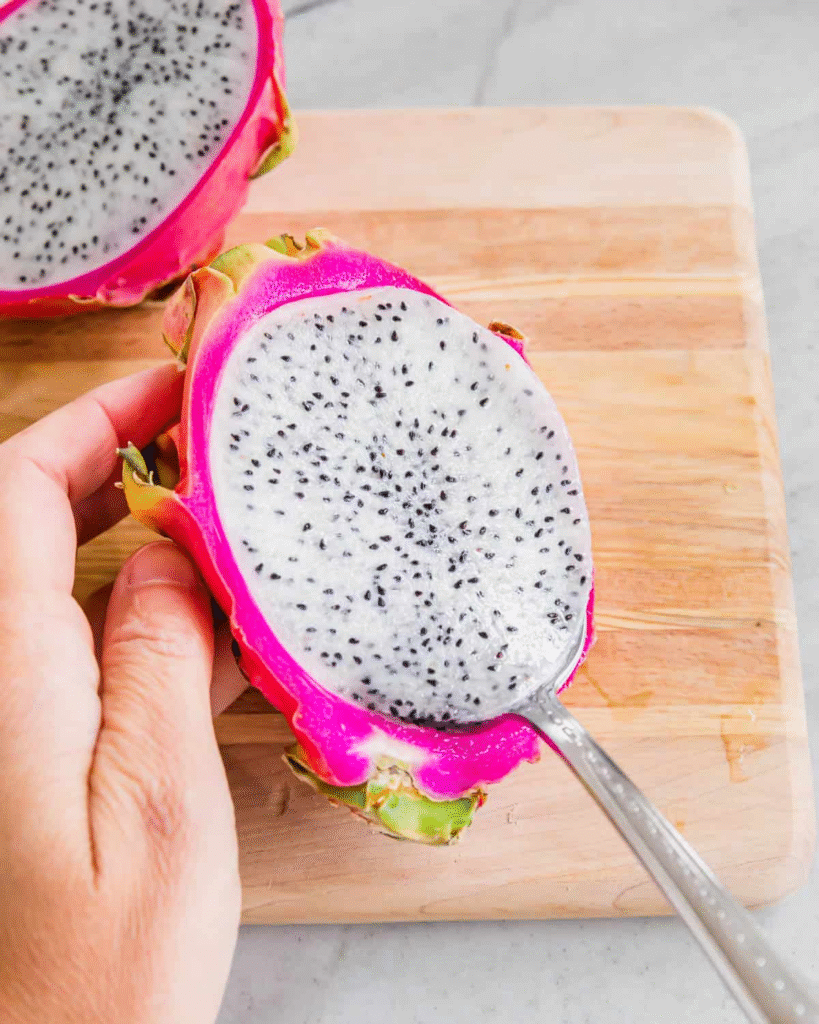
Method 1: Scoop with a Spoon
The easiest way to enjoy dragon fruit is by scooping the flesh out with a spoon, just like you would with an avocado. Simply run the spoon along the inside of the peel and lift the pulp out. This works best when the fruit is perfectly ripe. Keep in mind, though, that if you use a spoon that’s too small, you might leave a little fruit behind.
Method 2: Peel Back the Skin
If you want to make cleaner cuts, peeling is a great option. First, cut your dragon fruit half into quarters to create wedge-like pieces. Then, grab the tip of the peel and gently pull it back from the flesh. The fruit should separate easily without the need for extra tools, leaving you with perfect, ready-to-eat wedges.
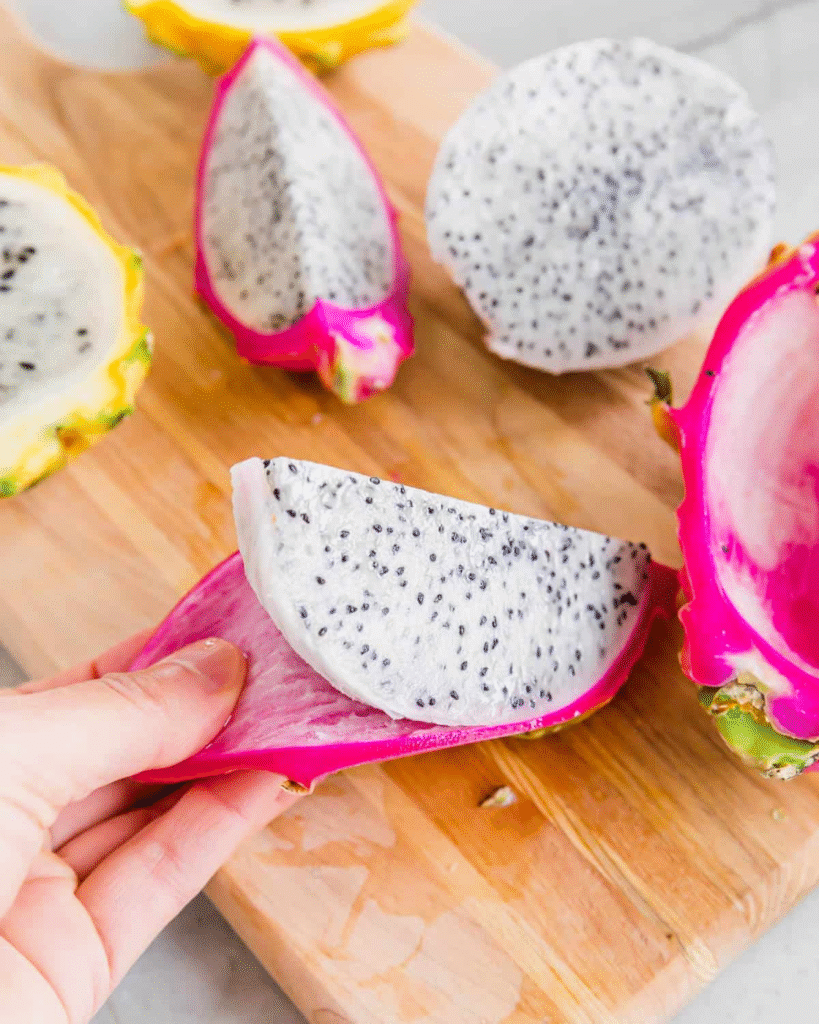
Step 3: Cut into slices
Once the flesh is separated from the peel, you can slice dragon fruit into thin half-moon shapes. Simply place the peeled or scooped sections on a cutting board and use a sharp knife to make even slices. These pieces look beautiful fanned out over a smoothie bowl or fruit platter.
For a decorative touch, you can even leave the peel on and slice the fruit as you would an orange, with the rind attached. This makes a fun garnish for drinks or desserts.
Step 4: Cut into Cubes
Another popular method is cubing. Start by slicing the flesh into strips, then rotate the fruit and cut across the strips to form small cubes. Cubes are perfect for snacking, tossing into fruit salads, or freezing to use in smoothies. Dragon fruit chunks blend especially well with papaya, mango, or banana for a tropical, nutrient-packed drink.
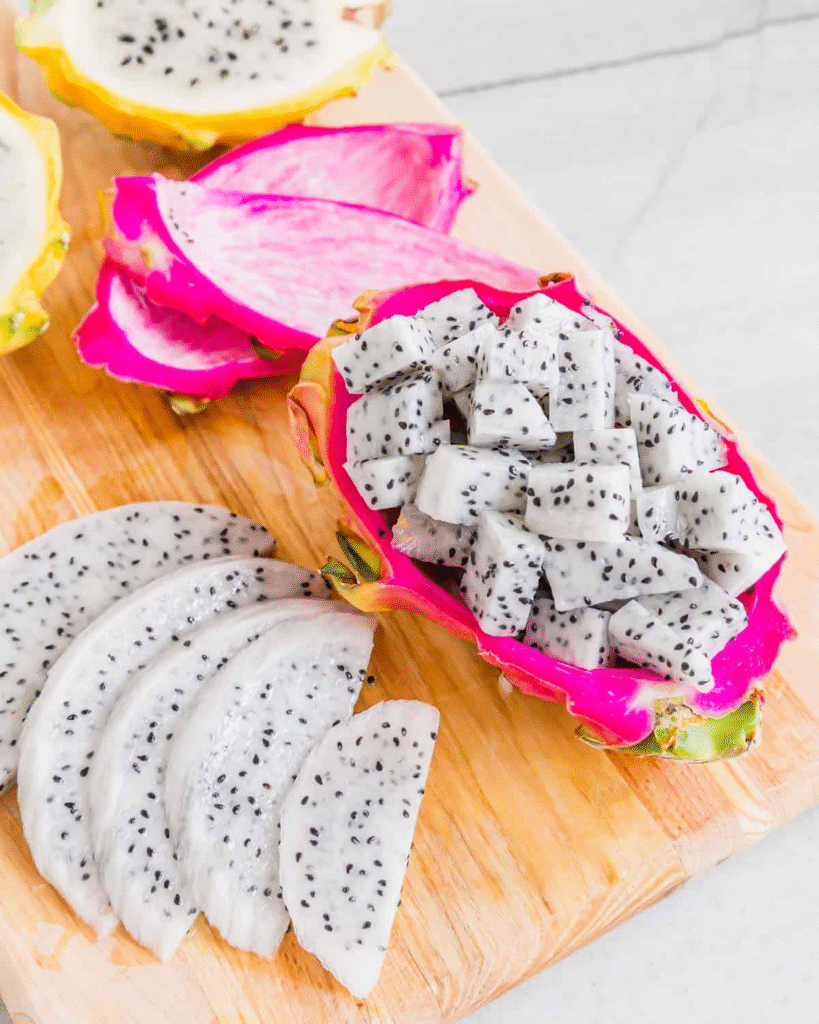
Step 5: Scoop into Spheres
For a playful twist, you can scoop the dragon fruit into bite-sized spheres. To do this, grab a melon baller (the same tool used for melons or coring pears). It works best when the fruit is still in its peel, right after slicing it in half.
Gently press the melon baller into the flesh and twist to form neat, round spheres. These little gems are not only delicious but also make a beautiful addition to smoothie bowls, fruit salads, or as a garnish for tropical drinks.
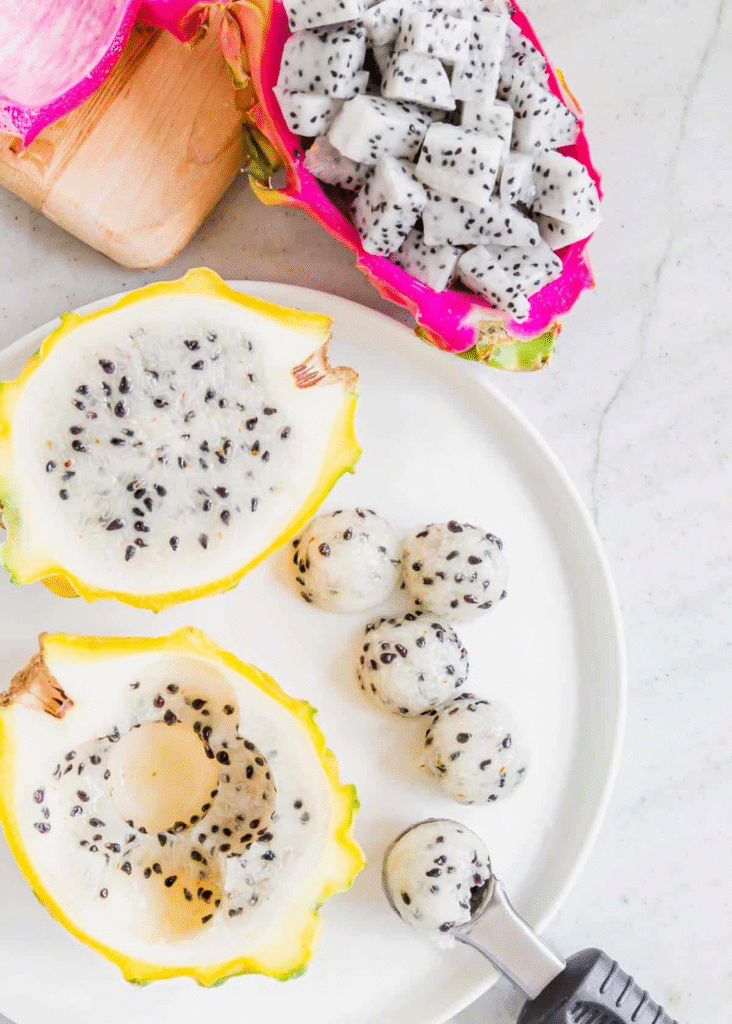
Frequently asked questions
What does dragon fruit do to your body?
While more research is still needed, early studies suggest that the antioxidants and nutrients in dragon fruit may play a role in protecting against several health issues. They’ve been linked to better blood sugar control, heart and liver support, improved brain health, and even a reduced risk of certain cancers.
What is the best time to eat dragon fruit?
You can enjoy dragon fruit any time of day — on its own, in smoothies, or tossed into a salad. If you’re shopping for it fresh, peak season usually runs from June through September, when the fruit is at its best.
